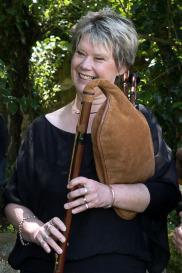The Bagpipe Society
Grace Notes

Another Chanter, another eclectic mix of articles. I am especially pleased to be able to print an account of the restoration of a rare musette à ravalement by Bart Van Troyen and his completion of the instrument is a real tour de force in the art of instrument making …. and reed making too! It is an honour for me, as editor, to be able to highlight and focus on the work that people are doing in order to preserve instruments from the past as they help inform the future. As has been shown, time and time again through the pages of this journal, bagpipes are inextricably linked to local cultures and traditions. Whilst the culture of the noble elite of the French court may not have much relevance to our lives today, this does not mean that the instrument should be consigned to the past. The finished instrument sounds simply glorious and I would encourage you to find and listen to Bart’s recording of it. Currently, there is only a sound clip on Facebook but all being well, further videos will be on the website Incidentally, there are also detailed plans of the instrument for those looking for a challenge!
I am grateful to Stjepan Večković for his article describing the variety of types of bagpipes found in Croatia. I was introduced to Stjepan through the story of the Daniele Bicego’s missing Diple (see Chanter, Summer 2020). I was aware that there were regional Croatian bagpipes but not the extent and range and, being a player as well as a maker, Stjepan is doing great work in reviving and popularising bagpipes in his home country. The revival of the bagpipe and making it relevant to today’s culture is an ongoing task for many. Close friend of The Bagpipe Society, Yannis Pantazis from Santorini, has been instrumental in promoting the tsabourna within Greece, the Greek Islands and further afield. Yannis’s enthusiasm and passion for the instrument was so clearly evident for those that had the pleasure of meeting him when he visited the Blowout a few years ago. Now, thanks to Yorgis Avanitis’s documentary, The Journey of Askavlos, everyone can see the results of his, and others, work in garnishing support and continuation of this instrument. In the UK we may assume that the bagpipes’ future is assured as there is now a greater knowledge of the instrument and its long history. However, as I sit playing my bagpipes in my role as historical interpreter for the National Trust and yet another visitor asks me what the instrument is and why I’m playing it, I know that we still have a long, long way to go to educate and inform. It is, however, great to discover that bagpipes are finding their way into new settings and new audiences thanks to the work of composers such as Gina Fergione.
From Chanter Summer 2022.
- Data Processing Notice (GDPR)
-
@BagpipeSociety on X (formally known as Twitter)
-
TheBagpipeSociety on Instagram
-
 BagpipeSociety on Facebook
BagpipeSociety on Facebook
Something wrong or missing from this page? Let us know!
